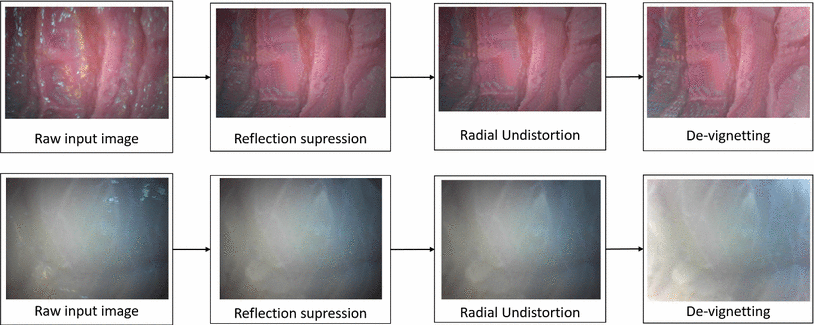Sparse-then-dense alignment-based 3D map reconstruction method for endoscopic capsule robots

Despite significant progress achieved in the last decade to convert passive capsule endoscopes to actively controllable robots, robotic capsule endoscopy still has some challenges. In particular, a fully dense three-dimensional (3D) map reconstruction of the explored organ remains an unsolved problem. Such a dense map would help doctors detect the locations and sizes of the diseased areas more reliably, resulting in more accurate diagnoses. In this study, we propose a comprehensive medical 3D reconstruction method for endoscopic capsule robots, which is built in a modular fashion including preprocessing, keyframe selection, sparse-then-dense alignment-based pose estimation, bundle fusion, and shading-based 3D reconstruction. A detailed quantitative analysis is performed using a non-rigid esophagus gastroduodenoscopy simulator, four different endoscopic cameras, a magnetically activated soft capsule robot, a sub-millimeter precise optical motion tracker, and a fine-scale 3D optical scanner, whereas qualitative ex-vivo experiments are performed on a porcine pig stomach. To the best of our knowledge, this study is the first complete endoscopic 3D map reconstruction approach containing all of the necessary functionalities for a therapeutically relevant 3D map reconstruction.
| Author(s): | Turan, Mehmet and Pilavci, Yusuf Yigit and Ganiyusufoglu, Ipek and Araujo, Helder and Konukoglu, Ender and Sitti, Metin |
| Journal: | Machine Vision and Applications |
| Volume: | 29 |
| Number (issue): | 2 |
| Pages: | 345--359 |
| Year: | 2018 |
| Month: | February |
| Day: | 01 |
| Bibtex Type: | Article (article) |
| DOI: | 10.1007/s00138-017-0905-8 |
| URL: | https://doi.org/10.1007/s00138-017-0905-8 |
| Electronic Archiving: | grant_archive |
BibTex
@article{Turan2018,
title = {Sparse-then-dense alignment-based 3D map reconstruction method for endoscopic capsule robots},
journal = {Machine Vision and Applications},
abstract = {Despite significant progress achieved in the last decade to convert passive capsule endoscopes to actively controllable robots, robotic capsule endoscopy still has some challenges. In particular, a fully dense three-dimensional (3D) map reconstruction of the explored organ remains an unsolved problem. Such a dense map would help doctors detect the locations and sizes of the diseased areas more reliably, resulting in more accurate diagnoses. In this study, we propose a comprehensive medical 3D reconstruction method for endoscopic capsule robots, which is built in a modular fashion including preprocessing, keyframe selection, sparse-then-dense alignment-based pose estimation, bundle fusion, and shading-based 3D reconstruction. A detailed quantitative analysis is performed using a non-rigid esophagus gastroduodenoscopy simulator, four different endoscopic cameras, a magnetically activated soft capsule robot, a sub-millimeter precise optical motion tracker, and a fine-scale 3D optical scanner, whereas qualitative ex-vivo experiments are performed on a porcine pig stomach. To the best of our knowledge, this study is the first complete endoscopic 3D map reconstruction approach containing all of the necessary functionalities for a therapeutically relevant 3D map reconstruction.},
volume = {29},
number = {2},
pages = {345--359},
month = feb,
year = {2018},
slug = {turan2018},
author = {Turan, Mehmet and Pilavci, Yusuf Yigit and Ganiyusufoglu, Ipek and Araujo, Helder and Konukoglu, Ender and Sitti, Metin},
url = {https://doi.org/10.1007/s00138-017-0905-8},
month_numeric = {2}
}

